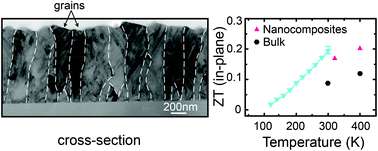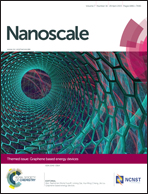Enhanced in-plane thermoelectric figure of merit in p-type SiGe thin films by nanograin boundaries†
Abstract
P-Type polycrystalline silicon–germanium (SiGe) thin films are grown by low-pressure chemical vapor deposition (LPCVD) and their thermoelectric properties are characterized from 120 K to 300 K for potential application in integrated microscale cooling. The naturally formed grain boundaries are found to play a crucial role in determining both the charge and thermal transport properties of the films. Particularly, the grain boundaries create energy barriers for charge transport which lead to different dependences of charge mobility on doping concentration and temperature from the bulk counterparts. Meanwhile, the unique columnar grain structures result in remarkable thermal conductivity anisotropy with the in-plane thermal conductivities of SiGe films about 50% lower than the cross-plane values. By optimizing the growth conditions and doping level, a high in-plane figure of merit (ZT) of 0.2 for SiGe films is achieved at 300 K, which is about 100% higher than the previous record for p-type SiGe alloys, mainly due to the significant reduction in the in-plane thermal conductivity caused by nanograin boundaries. The low cost and excellent scalability of LPCVD render these high-performance SiGe films ideal candidates for thin-film thermoelectric applications.


 Please wait while we load your content...
Please wait while we load your content...